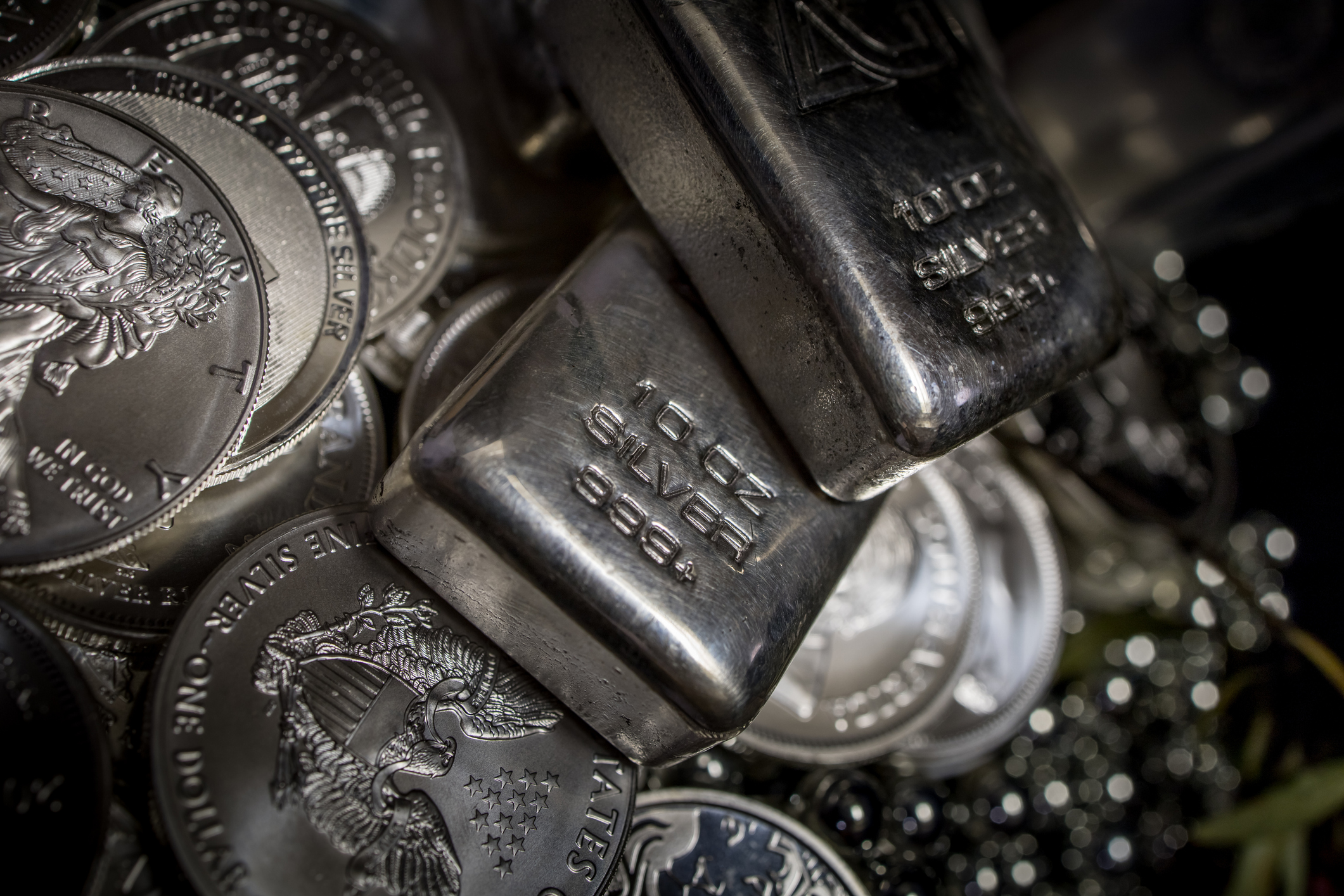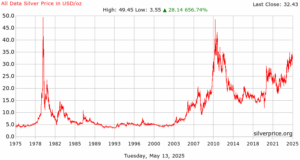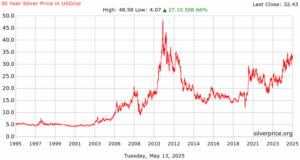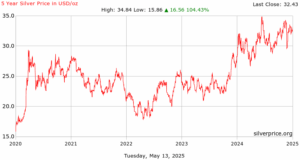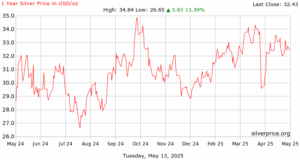Silver, often considered the companion to gold in the precious metals market, has its own unique story. For investors, understanding silver’s price history is crucial in making informed decisions about its potential as an investment. Over the past five decades, the price of silver has fluctuated significantly, influenced by everything from global economic shifts to technological advancements.
In this post, we’ll take a closer look at the historical silver prices, analyzing the key trends and what they might mean for silver’s future as an investment.
The Price History for Silver: A 50-Year Overview
The price of silver has seen dramatic highs and lows over the past 50 years, reflecting a mix of economic, political, and market factors. To better understand where silver stands today, it’s helpful to break down its performance across several decades.
1970s: Silver’s First Big Boom
In the early 1970s, silver prices were relatively low, hovering around $1.50 per ounce. However, that all changed when a series of global economic events led to a surge in silver demand. The end of the Bretton Woods system in 1971 (which decoupled the U.S. dollar from the gold standard) and the subsequent inflationary pressures caused silver to skyrocket. By 1979-1980, silver prices reached a historic peak of over $40 per ounce, driven by speculative buying and increased industrial demand. During this period, silver also became seen as a store of value during times of economic uncertainty.
1980s: Silver’s Crash and Recovery
After the speculative silver bubble burst in 1980, prices collapsed, falling to under $10 per ounce by the mid-1980s. The decade was characterized by relatively low volatility in silver prices, which stayed in the $4 to $7 range for most of the 1980s. It was a period of economic stability, with the global economy transitioning away from the oil crises of the 1970s.
1990s: Silver Struggles to Gain Traction
Throughout the 1990s, silver prices remained relatively stagnant, bouncing between $4 and $6 per ounce for much of the decade. Industrial demand for silver began to pick up, especially in electronics and solar energy, but silver’s role as an investment asset diminished. During this period, silver was seen more as a byproduct of mining operations than a precious metal in its own right.
2000s: A Gradual Resurgence
The 2000s marked the beginning of a new era for silver as both an industrial and investment commodity. From 2001 to 2008, silver prices slowly crept upward, hitting the $20 per ounce mark in 2008. The global financial crisis of 2008, similar to gold, caused investors to look for safe havens, and silver benefited from this. However, unlike gold, silver didn’t experience a massive spike during the crisis, with its price fluctuating between $10 and $20 per ounce.
2010s: The Silver Bull Market
The 2010s witnessed one of the most significant price surges in silver’s history. In 2011, silver hit its highest point since the 1980s, reaching over $48 per ounce. This price surge was driven by a combination of factors: economic uncertainty following the 2008 financial crisis, growing industrial demand (especially in electronics and solar panels), and speculative investments. However, the price wasn’t sustainable, and silver’s value gradually corrected, falling back below $20 per ounce by the mid-2010s.
2020s: The COVID-19 Pandemic and Silver’s Resilience
The COVID-19 pandemic of 2020 triggered a new wave of interest in precious metals, including silver. As global economies adjusted and governments rolled out massive stimulus programs, silver prices saw a significant boost. In 2020, silver prices surged above $25 per ounce, driven by a renewed interest in safe-haven assets and increasing demand in the green energy sector, particularly for use in solar panels.
As of 2024, silver has stabilized around $22-$25 per ounce. However, with growing interest in green technologies and the continued use of silver in industrial applications, its long-term outlook remains very promising.
The Price Per Gram for Silver: Key Numbers to Know
For investors looking to track silver’s value, it’s important to note that the price per gram for silver is directly tied to the price per ounce, but converted into smaller increments. With silver typically priced around $22 per ounce in recent years, this translates to approximately $0.71 per gram. This price per gram can vary slightly depending on market conditions, but it provides a useful benchmark for gauging silver’s value.
Silver as an Investment: A Strong Case for Diversification
As an investment, silver offers both potential rewards and risks. The metal serves as a hedge against inflation, just like gold, but its price volatility can be higher due to its smaller market size and industrial demand fluctuations.
Pros of Investing in Silver:
- Hedge Against Inflation: Like gold, silver is often seen as a safe-haven asset in times of economic uncertainty or inflationary pressures.
- Industrial Demand: Silver is used in various industries, including electronics, solar panels, and medical equipment. This creates a constant demand for silver beyond its role as a store of value.
- Affordability: Compared to gold, silver is much more affordable, making it accessible to a broader range of investors.
Cons of Investing in Silver:
- Price Volatility: While silver can yield high returns, it is also prone to significant price swings, making it riskier than more stable assets like bonds or blue-chip stocks.
- Storage and Insurance: As with any precious metal, storing and insuring physical silver can add costs, especially for larger holdings.
How Do Silver Prices Compare to Gold?
While gold has long been the more popular choice for investors looking for precious metals, silver’s affordability and growing industrial demand make it an attractive alternative. Historically, silver has followed gold’s lead during periods of economic uncertainty, but it tends to be more volatile. If you’re considering silver as part of your portfolio, it’s important to understand that while it can offer impressive returns, it may also experience steeper declines in price during times of market stability.
Looking Ahead: The Future of Silver Prices
Looking ahead, silver’s future remains tied to a combination of economic factors, industrial demand, and its role in financial markets. With increasing interest in renewable energy and the growing adoption of solar power, silver’s industrial demand is expected to rise. Moreover, as silver’s price remains relatively affordable compared to gold, it’s likely to continue attracting investors looking for diversification and a hedge against economic instability.
Final Thoughts
Silver has seen significant price fluctuations over the last 50 years, with periods of extreme highs and lows. While its price is not as stable as gold’s, silver remains an attractive investment for those seeking a hedge against inflation, industrial demand, and diversification in their portfolios. Whether you are looking at the historical silver prices or considering silver as an investment, understanding the metal’s price movements over the decades is key to making informed decisions.
Sell Your Silver with Confidence at Gold Guys
At Gold Guys, we specialize in offering great prices for your silver jewelry, coins, and other precious metals. We work closely with you to ensure a smooth and transparent process, providing you with the best value for your silver based on current market conditions. Find a Gold Guys location near you or request our mail-in service.

